Matador Network's Blog, page 398
October 21, 2022
10 Cozy Airbnb Cabin Rentals in the Northeast for the Perfect Mountain Escape
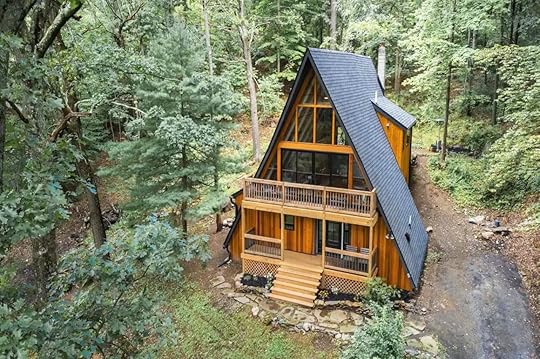
As summer comes to a close and the cool fall weather moves in, it’s time to plan a getaway to snuggle up by the fire with your favorite warm beverage. There’s no better way to bring in the fall season than to relax in a cozy cabin, and from New Hampshire to Maine, the Northeast is loaded with them. Shield yourself from the cold weather and snow, while taking in stunning views, at these secluded, intimate, and quaint cabins.
Matador’s guides to the best of Airbnb Categories:10 Remote, Off-The-Grid Airbnbs Where You Can Get Away From It AllThe 11 Most Beautiful Converted Churches You Can Stay in Around the World on AirbnbAirbnb Just Made Windmills a Category, and These 9 Have Us Planning a TripAirbnb Now Has a Towers Category. These 9 Will Climb Your Bucket ListAirbnb Launched a Tiny Homes Category, and We’re Already Planning Trips Around These 1111 Properties in Airbnb’s New OMG! Category You Won’t Believe Are Real
We hope you love the Airbnb cabin rentals in the northeast we recommend! Just so you know, Matador may collect a small commission from the links on this page if you decide to book a stay. Listed prices are accurate as of the time of publication.
The coziest Airbnb cabins in MaineThe coziest Airbnb cabins in New YorkThe coziest Airbnb cabins in MassachusettsThe coziest Airbnb cabin in New HampshireThe coziest Airbnb cabins in VermontThe coziest Airbnb cabin in Rhode IslandThe coziest Airbnb cabins in Maine
Caribou Mountain Retreat
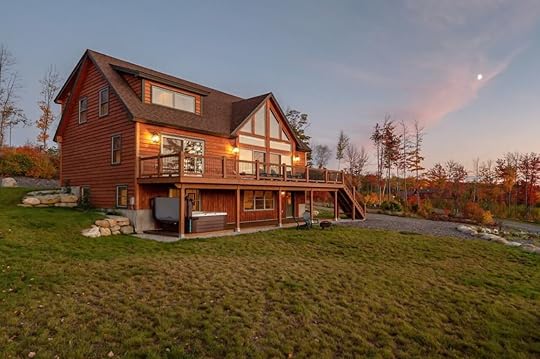
Photo: Airbnb
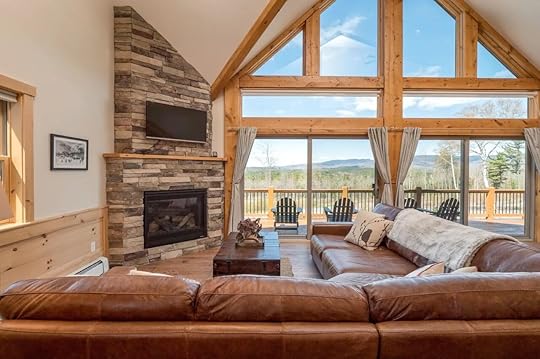
Photo: Airbnb
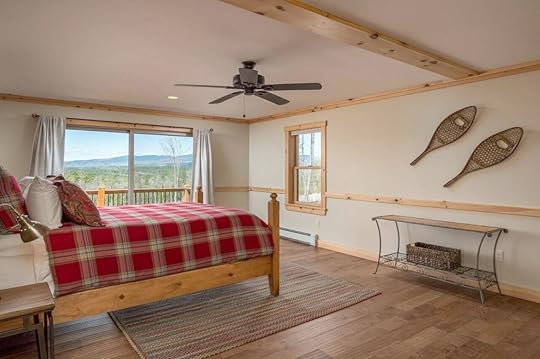
Photo: Airbnb

Photo: Airbnb
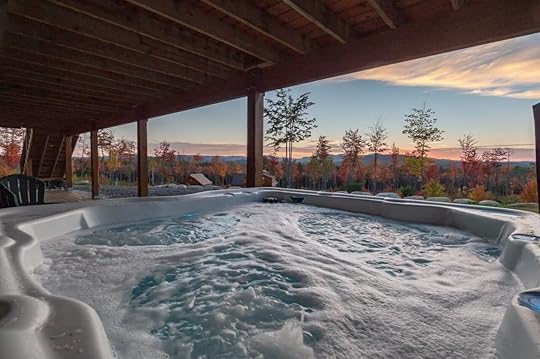
Photo: Airbnb
Check out some relaxing cabins in the Northeast, starting with this cozy one in Bethel, Maine. This cabin features 180-degree views from every corner and window in the cabin. The main floor features a kitchen area, a spacious living room, and a primary suite with a full bath.
Ten guests, four bedrooms
Price: $596 per night
Timber framed cottage

Photo: Airbnb
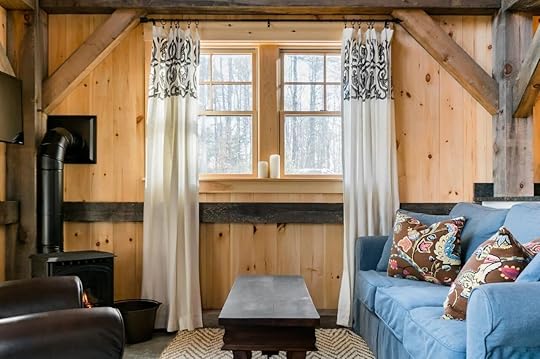
Photo: Airbnb

Photo: Airbnb

Photo: Airbnb
Sit back and relax in this comfortable space in a woodsy setting. This cottage has everything you need for a cozy stay, with modern amenities throughout the cabin. Chill by the wood fireplace place, snuggle up on the couch, or gather around the fire pit and roast some delicious marshmallows.
Four guests, one bedroom
Price: $267 per night
The coziest Airbnb cabins in New York
The Upstate A

Photo: Airbnb
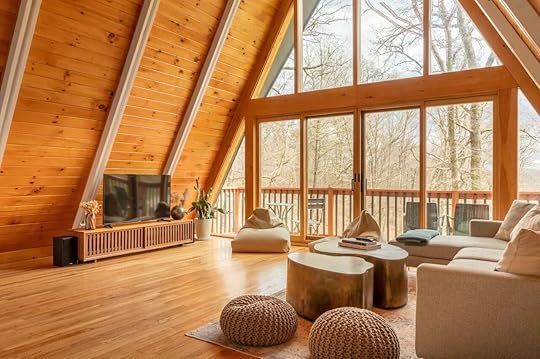
Photo: Airbnb

Photo: Airbnb

Photo: Airbnb
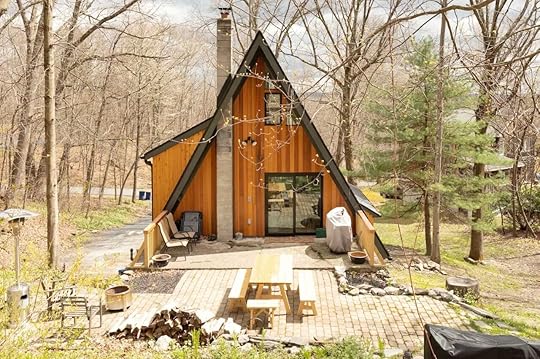
Photo: Airbnb
This A-frame cabin is set in a cul-de-sac in the heart of the Hudson Valley. It features a spacious living room, a modernized kitchen, a bar cart, plenty of board games for entertaining, a book nook, and exercise equipment, and if you need to get some work done, the home has two office setups.
Seven guests, four bedrooms
Price: $435 per night
Modern cabin getaway

Photo: Airbnb
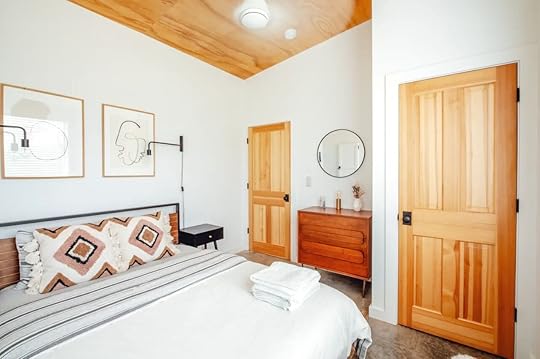
Photo: Airbnb

Photo: Airbnb
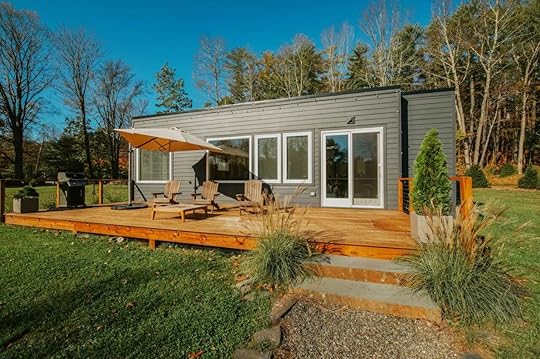
Photo: Airbnb
Experience modernity in the woods at this contemporary retreat. This Airbnb cabin rental in New York has bright windows that allow the home to fill with natural light, along with open space, new appliances, heated floors, and a bumping sound system. This cabin is a five-minute drive to Woodstock, and you can hike Overlook Mountain, have a stunning view of waterfalls, and take on more cool adventures near the cabin.
Four guests, two bedrooms
Price: $334 per night
The coziest Airbnb cabins in Massachusetts
Chic romantic cabin
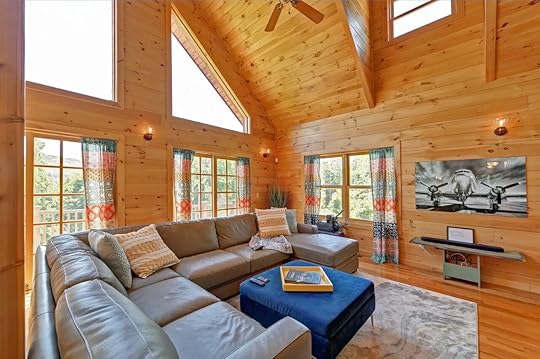
Photo: Airbnb

Photo: Airbnb

Photo: Airbnb
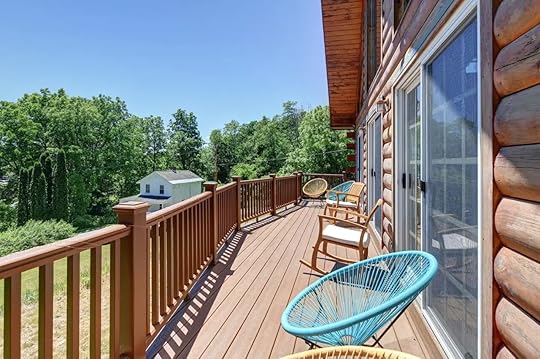
Photo: Airbnb
Gather the family and head to this chic, updated cabin in Great Barrington, Massachusetts. This spacious cabin is in the heart of downtown and features a cozy and spacious living room, a fully equipped kitchen, and an outdoor area with a large deck with rocking chairs and stunning views overlooking the mountains. If you’re looking to explore, the cabin is a 20-minute drive to Tanglewood, five minutes to Ski Butternut, 15 minutes to Catamount Mountain Resort, and within walking distance to many shops and restaurants.
Fourteen guests, three bedroom
Price: $386 per night
Berkshires Log Cabin
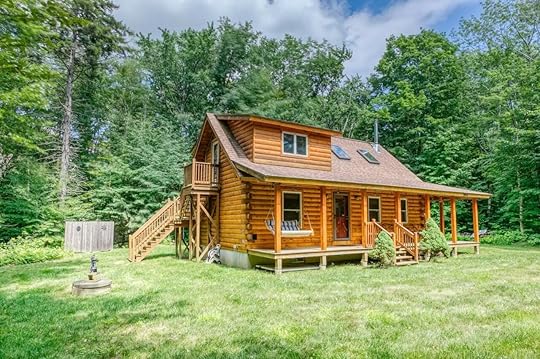
Photo: Airbnb
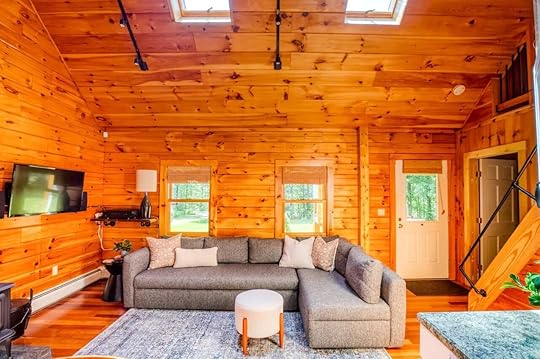
Photo: Airbnb
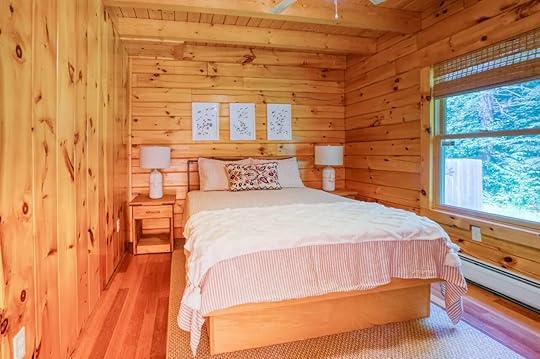
Photo: Airbnb
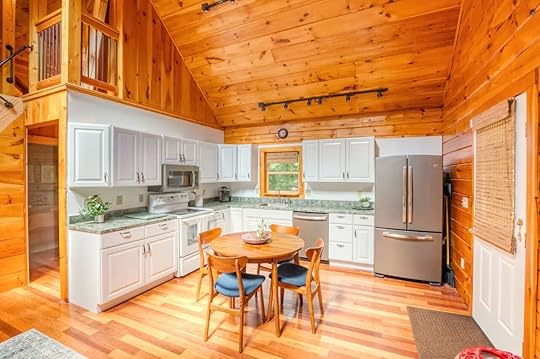
Photo: Airbnb
Immerse yourself in one of the cutest cabins in the northeast, this tranquil log cabin in Washington, Massachusetts. This secluded log cabin has an open-concept living space on the first floor and a loft area with a pullout queen sofa and ensuite bathroom. A wrap-around front porch is perfect for sitting out for coffee in the morning.
Six guests, three bedrooms
Price: $208 per night
The coziest Airbnb cabin in New Hampshire
Cozy White Mountains Cabin
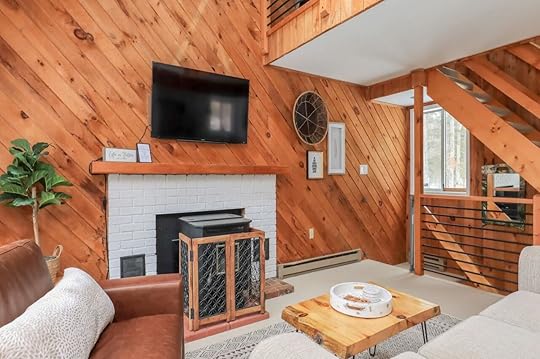
Photo: Airbnb
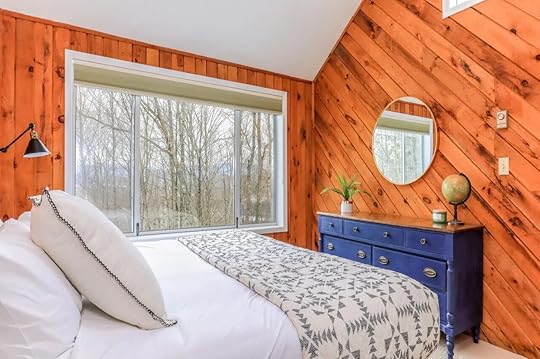
Photo: Airbnb

Photo: Airbnb
Take a break from reality at this renovated cabin in the White Mountains. This Airbnb cabin rental in New Hampshire is in the Waterville Estates neighborhood of Thornton and features resort-like amenities. Get cozy by the warm pellet stove, grab your favorite book, and get comfortable in the loft. The cabin is twenty minutes to Waterville Valley, twenty-five minutes to Loon, and thirty minutes to Cannon Mountain.
Six guests, three bedrooms
Price: $279 per night
The coziest Airbnb cabins in Vermont
Secluded Vermont cabin
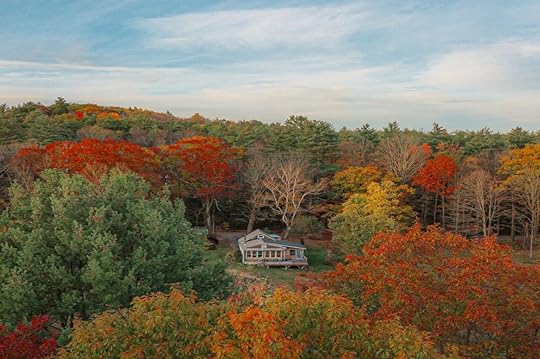
Photo: Airbnb

Photo: Airbnb
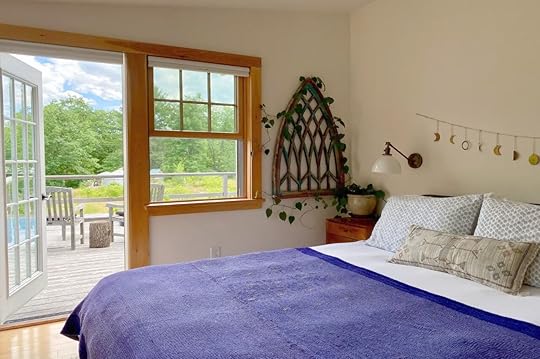
Photo: Airbnb

Photo: Airbnb
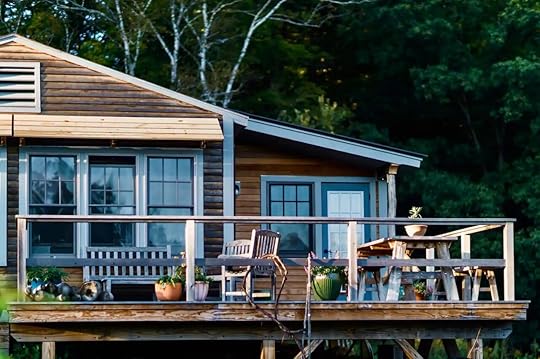
Photo: Airbnb
If you are looking for a romantic getaway for two, this secluded retreat is the place to be. The cabin is surrounded by nature and is on a six-acre farm. The cabin features a wood stove, a reading nook, and a deck with stunning views, and the home is near a ski resort, trails, and swimming holes.
Three guests, one bedroom
Price: $245 per night
Green Tree Cabin
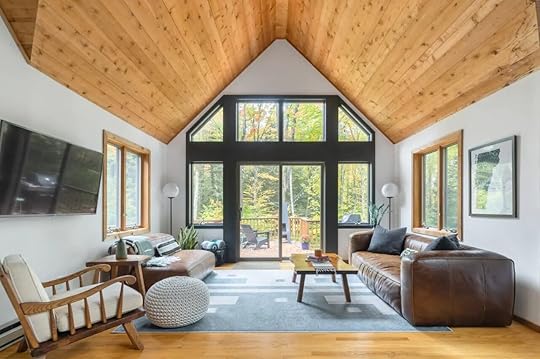
Photo: Airbnb

Photo: Airbnb

Photo: Airbnb
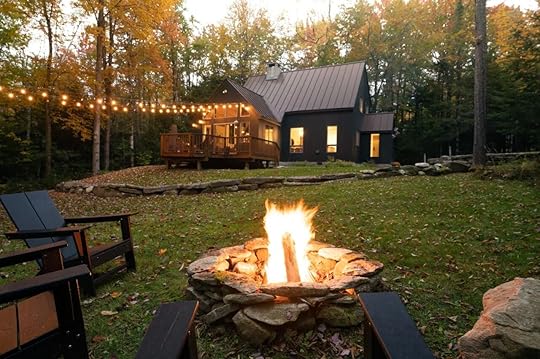
Photo: Airbnb
Escape to this stylish cabin for a simple Vermont getaway. This stylish Airbnb features modern amenities like a newly renovated kitchen, a spacious living room with floor-to-ceiling windows, and a cozy fireplace. The home has a large backyard area perfect for cool nights where you can sit by the fire pit and enjoy the cool air.
Eight guests, three bedroom
Price: $450 per night
The coziest Airbnb cabin in Rhode Island
Little Compton Modern

Photo: Airbnb

Photo: Airbnb

Photo: Airbnb

Photo: Airbnb
This newly renovated space sits on 2.4 acres in the heart of Little Compton. The space features unique furnishings throughout the home. The first floor features an outdoor shower, a sitting area with a vintage music system, and books to read. Enjoy relaxing in the living room or cooking a meal in the oversized kitchen. 
Ten guests, four bedrooms
Price: $450 per night
This Alaska Cruise Will Convert You To the Cruising Lifestyle With Animal Watching, Quality Food, and Music

Cruises can have a bad rap in certain circles. They’re labeled as for the olds, the buffet-obsessed, and those who are too lazy to plan an itinerary of their own. Intrepid travelers love to turn their noses up at cruises, as if you’re not really traveling if you don’t sleep on an airport’s dirty carpet or endure bumpy bus rides. But there’s no shame in enjoying comfort and relaxation while seeing the world, and cruising is not all about eating average food, sitting poolside, and visiting the most touristy of tourist attractions when at port. Cruises are for everyone and can be customized to suit every traveler, whether they venture out for food, the outdoors, culture, or just a family escape.
I never thought I would enjoy a voyage on a large ship with over 2,500 other passengers, but my recent trip on Holland America’s Koningsdam from Vancouver to Alaska proved me wrong. It was one of the best trips of my life. Taking a Holland America Alaska cruise will not make you lose travel street cred, it’ll open up your mind to a way of traveling that can be unbelievably fun.
For those who travel for foodFor the outdoor adventurers of all levelsFor the culture and entertainment enthusiastsFor travelers with disabilitiesFor the fitness-obsessed and the spa loversFor the families with childrenFor the independent travelersFor the nature-focused travelersHolland America Alaska cruise foodYes, there is a buffet section on Holland America’s Koningsdam, but the Lido Market, as it’s named, is not the only place to eat on board. Also, it’s a lot more than a free-for-all spread of cold cuts. Like the name indicates, it works like a market, with stalls for each type of food on offer. There’s a bread station with a large variety of baked goods, a salad section with a selection of crudités, a dessert and ice-cream stand, a carved meat counter, etc. The choice is impressive and appetizing. It’s not a self-serve buffet — trained staff manage each station, take orders, and hand out the food. The Lido Market is open for all three meals, but you don’t have to have any of them there.

In the main dining room, you can sit in the very back and enjoy great views with your meal. Photo: Jesse Adams

Stealing some fries from my partner's lunch in the main dining room. (After getting my nails done at the onboard Greenhouse Spa.) Photo: Jesse Adams
Instead of going to the Lido Market, passengers can go to the main dining room for breakfast, lunch, and dinner and have a sit-down meal with a different menu every day. The dining room is fancy affair, with grand decor and white-shirted staff trained in hospitality. The choice is more limited than at the Lido Market, but the food is of higher quality and the atmosphere is a lot more quiet and fancy. Your chair is pulled out for you and your napkin placed on your lap before you are given the menu. There’s no extra charge for choosing to eat your meal at the dining room instead of the Lido market. It’s only a matter of preference.

The Club Orange restaurant. Photo: Jesse adams

Bento box breakfast in the Club Orange restaurant. Photo: Jesse Adams

There are a large variety of breakfasts available in the Club Orange restaurant, including an Indian cuisine-inspired plate. Photo: Jesse Adams

Swedish pancakes for breakfast, and a lovely dessert in the Club Orange restaurant. Photo: Jesse Adams
Passengers, like me, who paid for Holland America’s Club Orange package ($175 per person for the entire length of the sailing), have access to an entirely separate, and much more intimate, restaurant for breakfast and dinner (lunch is served in the main dining room). There’s a new menu every day and you can choose whatever you want from it. The food is high-end and so is the exceptional staff. There’s unlimited freshly squeezed orange juice and mimosas every morning, as well as a range of baked goods and delicious breakfast items like Swedish pancakes, fruit, French toast, Japanese-style bento boxes, and more. Dinner at the Club Orange dining room was just as indulgent, with three-course meals I’m not going to forget any time soon.

36-oz steak and crème brulée for dessert? Don’t mind if I do! Photo: Morgane Croissant
There are specialty restaurants on every Holland America ship heading to Alaska. On the Koningsdam, there were five: The Pinnacle Grill (steak house), Canaletto (Italian fare), Tamarind (Southeast Asian cuisine), Nami Sushi, and Rudi’s Sel de Mer (seafood), all of which are at an additional cost. I tried the Pinnacle Grill on the first night and had the most delicious mushroom soup I’ve ever tasted while my partner tried “the largest steak at sea”: a 36-ounce Tomahawk bone-in ribeye.

Enjoying a bossche bollen and lattes from the Grand Dutch Cafe. Photo: Jesse Adams

The New York Pizza restaurant on board had a large selection of handmade pies. Photo: Jesse Adams
If it’s a Dutch treat you’re after in a nod to the cruise line’s origins, the Grand Dutch Café (available on the Koningsdam, the Nieuw Statendam, and the Rotterdam) serves Dutch spirits like genever and advoccaat, and snacks like bossche bollen (dough filled with whipped cream and covered in Chocolate). Pizzas, hot dogs, fries, and burgers can be had at the Dive-In or the New York Pizza stands.
Holland America Alaska cruise for the outdoor adventurers of all levelsThe choice of shore excursions on Holland America Alaska cruises is vast, and most are outdoors focused so you can fully enjoy Alaska’s beauty. The variety of excursions provides all fitness levels with suitable options, from easy to strenuous.
In Juneau, passengers could choose to go whale watching, dog-sledding, biking, zip lining, trekking on a glacier, and more. I’m not particularly fit or outdoorsy, but I chose to embark on a traditional Tlingit-style canoe across Mendenhall Lake while my partner went salmon fishing (a very Alaskan endeavor). In Ketchikan, I went for a nature walk in the Tongass National Forest while my partner went fishing again on a wilderness boat adventure. The options are so varied on Holland America Alaska cruises that even the most athletic and outdoorsy person will find something that fits their need and their interests.
Shore excursions are at an additional cost and some of them are very pricey. Select your excursions as soon as you’ve booked your cruise to ensure you don’t miss out on your activity of choice, but take the time to look at them all carefully. If you can only afford one, make it count.
Holland America Alaska cruise for the culture and entertainment enthusiasts
Blues perfomance on board the Koningsdam. Photo: Jesse Adams

Classical music performance on board the Koningsdam. Photo: Jesse Adams
The shore excursions on Holland America’s Alaska cruises are not all outdoorsy, many are designed with a focus on history and culture. In every port during my cruise, there were excursions focusing on the story of the gold rush, especially in Skagway where the Chilkoot Trail starts, as well as on Indigenous history and culture with performances and visits to totem parks and museums. But the activities on the ship also provided culture lovers with opportunities to smile.
The musical entertainment on the Koningsdam exceeded my expectations, with a variety of shows each as packed with talent as the next. There were classical music and dance performances, as well as rhythm and blues, rock n’ roll, and piano and singing concerts nightly. The musicians gave their all during each show and the crowds responded with applause and hours of dancing and singing-along.
Beyond the music and dancing, movies were shown most nights on the giant screen on the indoor pool deck, and fascinating destination-themed presentations about wildlife, the Iditarod, and more, were peppered throughout the sailing.
Holland America Alaska cruise for travelers with disabilitiesWhile my partner and I are able-bodied, many travelers on our cruise were wheelchair bound. Holland America is determined to make it as easy as possible for those who have mobility issues to travel the world.
On the ship, all performance venues and restaurants are wheelchair accessible, and the elevators, ramps, and wide gangways facilitate the movement of those with disabilities. Most decks are also wheelchair accessible and there are accessible restrooms throughout the ship. There were 27 accessible staterooms on the Koningsdam.
A large number of shore excursions were designed and reserved for people with mobility issues. In Juneau, wheelchair users were able to go gold panning and explore an underground mine, see the Mendenhall Glacier up close, and go whale watching. In Skagway, passengers in wheelchairs could take a drive or train ride to White Pass summit and meet sled dogs. In Ketchikan, a wilderness cruise in Misty Fjords National Monument and attend an Indigenous performance.
Holland America Alaska cruise for the fitness-obsessed and the spa lovers
Photo: Jesse Adams

Photo: Jesse Adams
Being on a ship for seven days may not seem like the ideal situation for those who exercise daily when at home, but, in reality, there are many opportunities for the fitness-obsessed to sweat it out. Holland America’s ships have huge fitness centers on board with all the equipment you’d find at your own gym and more. Of course, there are also pools for swimming short laps for those who don’t mind weaving in between leisure bathers. For those who prefer to exercise in the fresh air, there’s a jogging/walking track and a basketball court that can be transformed into a pickleball cpurt. There are also sunrise stretch sessions, abs classes, yoga, Tai Chi, and more organized regularly throughout the week.
On the other end of the spectrum are the spas. On the Koningsdam, the Greenhouse Spa and Salon provides a huge variety of treatments, including massages, while the high-end Greenhouse Retreat allows passengers to fully relax with saunas, steamed rooms, heated lounge chairs, and a hydropool filled with warm sea water. You can purchase a seven-day pass to access the Greenhouse Retreat when you arrive on board for $149, or get a day pass any time during the trip for just $49. Note that access to the Greenhouse Retreat is limited to a small number of people so don’t wait until the last minute to get your pass.
Holland America Alaska cruise for families with children
The indoor pool on the Koningsdam. This is also where movie nights take place. Photo: Jesse Adams

The outdoor pool on the Koningsdam on a grey day. The pool is heated and the hot tubs are fabulous. Photo: Jesse Adams
On my Holland America Alaska cruise, there were people of all ages, including families with children from toddlers to teens. Of course, with family-friendly movie nights, pools, and ping-pong tables on board it’s easy to keep kids entertained, but Holland America goes one step further to accommodate families with children. Club HAL is an activity and entertainment program for children ages three to 17. Supervised by trained staff, children, including those with special needs, can work on age-appropriate crafts, art, team games, video games competitions, and more. Club HAL is available on nine Holland America ships.
Holland America Alaska cruise for the independent traveler
Photo: Morgane Croissant and Jesse Adams
If you don’t want to book an excursion and would rather do your own thing while docked at port, nobody’s going to say you can’t. You can pack your things for the day and head to town, exploring the area on your own and doing whatever you choose. Granted, the ship doesn’t stay in port for more than a day and your time in one place is limited, but if you don’t like having things tightly scheduled, you are free to roam. It’s not much different than leaving an Airbnb or hotel room for the day and going back to it at night, really.
While on board, it’s the same story. You don’t have to sit down for dinner, attend the concerts, or listen to the talks. It’s your vacation and you can do as you please with your time, whether that means ordering room service for all your meals so you can eat in your own space or read a book in the Crow’s Nest lounge at the top of the ship when everyone is dancing the night away downstairs.
Holland America Alaska cruise for the nature-focused travelers
Photo: Jesse Adams

Photo: Jesse Adams

Photo: Jesse Adams

Spot the orcas! Photo: Jesse Adams

Photo: Jesse Adams
The deck of a cruise ship is an amazing spot to see wildlife when you’re traveling to Alaska. On Holland America’s Alaska cruises, wildlife spotting sessions are led almost daily by a resident naturalist who will point out what you should be looking for at each location. Obviously, you can (and should) also pick up your binoculars and look for animals on your own time. During my Holland America Alaska cruise, I was lucky enough to spot hundreds of sea otters, humpback whales, seals, eagles, dolphins, and orcas from the top deck.
But beyond the wildlife, a Holland America cruise to Alaska is one of the best ways to see spectacular scenery, especially that of Glacier Bay National Park. This national park is only accessible by boat or plane, and a cruise ship gets incredibly close to all the best areas of this magnificent place, including Lamplugh Glacier, Johns Hopkins Glacier, and the king of them all, Grand Pacific Glacier. I would strongly recommend to select a Holland America Alaska cruise that has Glacier Bay National Park on its itinerary as it was the highlight of my trip. And if you can, go in the fall; in the summer, the inlets where the glaciers are located are off limits because there are breeding grounds for seals, but in the fall, it’s open to wow visitors. 
October 20, 2022
A French Cheese Pull Competition Found Who Makes the Stretchiest Aligot

Whether it’s aged parmesan, Wisconsin cheddar, or a crumbly Gruyère, cheese lovers everywhere crave the satisfying indulgence that is cheese. France should be at the top of the list for anyone looking for a delectable bite. With between 350 and 400 official varieties of cheese, the country rivals Italy and Switzerland for the perfect chance to savor some ooey gooey goodness. In fact, The Laguiole AOP Cheese Association, which is dedicated to the preservation of Laguiole cheese (I can’t make this up), held it’s first fete du Laguiole (Laguiole festival), where chefs competed in a cheese pull competition to see who could whip up the stretchiest Aligot.
View this post on InstagramA post shared by @jeunemontagne
Aligot de l’Aubrac is a must-have on trips to central or southern France. With a fondue-like appearance, the dish is a super cheesy mashed potato made with potatoes, cream, and Tomme d’Auvergne or Tommes de Laguiole cheese. The dish is often served as a side with sausage or pork, or on its own with garlic placed on top. Jeune Montagne, the primary producer of Laguiole AOP cheese made from raw, whole milk, managed to spin the Aligot de l’Aubrac to about 16 feet.
The first Laguiole AOP festival was held in July of this year in Laguiole, France, and included other activities like live cow milking, tastings, culinary workshops, and games for children. Next year’s festival hasn’t been announced yet, but if you want to see this cheese pull competition in person, keep an eye out. In the meantime, there are plenty of places worldwide for a unique cheese experience. 
You Can Stay Overnight at a Frank Lloyd Wright House in Pittsburgh’s Polymath Park

Pittsburgh is known for many things: a fierce loyalty to local sports teams, French fries on salads (yes, it’s a thing), and Andy Warhol, to name a few. It’s a city with more than 200 overcast days on average, and is divided by three rivers and 446 bridges that criss-cross 90 neighborhoods. Recently, Pittsburgh has made a name for itself as a tech hub with business owners that have received an injection of venture capital that has made the city, once again, a place of industry.
What Pittsburgh gets less attention for is its architecture. The city appears like a patchwork of buildings absurdly placed along the geographic diversity of hill, riverbank, and urban sprawl. Outside of Pittsburgh’s famous neo-Gothic buildings, any architectural beauty seems to have flourished despite its location, not because of it.
For the real architectural wonders, locals like myself know that you should drive about an hour outside the city to a hodge-podge of mid-century houses that span a 15-mile radius from the nearest turnpike exit in a town called Donegal. Here, you’ll find the famous Frank Lloyd Wright buildings Fallingwater and its little brother, Kentuck Knob. While I don’t want to gloss over the beauty of these two architectural phenoms, the real gems lie on a wooded lot that houses four – yes four – mid-century modern houses in Polymath Park. And the real kicker? You can stay overnight in any of them.
Polymath Park: A historyView this post on InstagramA post shared by Wright At Polymath Park (@wrightatpolymathpark)
The site now known as Polymath Park began as a commune of sorts for two families: the Balters and the Blums. Entrepreneurs from Pittsburgh, they purchased 130 acres of woodland in what is called the Laurel Highlands in Western Pennsylvania for a country home to escape to on the weekends. During this time, they began working with the Frank Lloyd Wright apprentice Peter Berndston to build accommodations for the families.
These two houses, which are still operational today, became the seedling for a larger project nearly 40 years later when the Papinchak family (who lived in an adjacent mid-century mountain retreat) purchased the Balter and Blum houses to save them from redevelopment (or worse, a complete tear-down for another Dollar General).
By 2006, the Papinchaks were becoming known in conservation circles for their dedication to Polymath. The Papinchaks were offered the opportunity to take ownership of the Duncan house, a Wright property originally from Illinois, after the original plans to relocate the property to a nearby town as the centerpiece of a botanical garden fell through. Nine months later, the property was taken from its original home in pieces, transported to Polymath, and rebuilt and opened to the public alongside its Blum and Balter siblings.
A year later, Polymath opened to the public, offering an in-person experiential tour of Wright’s Usonian design up close and personal. Overnight lodging started the same year to allow guests to sleep in a living piece of American history.
View this post on InstagramA post shared by Wright At Polymath Park (@wrightatpolymathpark)
Amazingly, the conservancy efforts have never wavered for the Papinchak family, who, in 2016, had a similar opportunity with a property called Mäntylä as they did with Duncan. Nearly a decade after first transporting a house piece-by-piece, they did it again — furniture and all — only this time from Minnesota.
Today, Polymath Park is an unlikely tourist destination in the middle of nowhere (and I say that lovingly, living only 15 minutes from the site). To see four Usonian buildings rise out of the wooded acreage of the park is somehow jarring and somehow so fitting to the overall philosophy of Wright himself: to build with nature, not against it.
The Polymath Park housesAll four houses take after Wright’s Usonian architectural style. The style emphasizes a relationship with nature, a passive relationship between interior and exterior materials, and an angular blueprint that strongly contrasts with the natural surroundings. While these are the basic principles, each of the four Polymath Houses, two from Wright himself and two from his apprentice Berndtson, has its own personality.
The Duncan house provides ample sunlight in the main living area while emphasizing compartmentalized spaces, toying with perspective and space.

Photo: Brett F. Braley
Mäntylä, the most impressive to me, remains largely untouched from the original owners, whose children donated everything from Christmas decorations to family photos to the conservancy. Built-in furniture faces one wall of the large, windowed living space, which is the most impressive feature of the property. The remainder of the house, a trademark of many Wright homes, is diminutive for the “private” quarters and is reminiscent, as a tour guide told me on a visit, of a naval ship’s cabin.
The Berndtson properties are no less dramatic, but you can feel the shift between master and apprentice when entering the Blum and Balter properties. Both properties contain familiar elements of Wright’s principles – Cherokee red concrete, geometric playfulness, and a nod toward elemental integrity with nature — but it’s all on a more diminutive scale. These were, of course, family homes to be lived in, and they feel homey in the right sense of the word.
Staying overnight at a Frank Lloyd Wright houseAll of the four houses mentioned above – Blum, Balter, Duncan, and Mäntylä – are available for overnight lodging. It can’t be stressed enough the rarity of being able to stay overnight in a Wright property. This is the closest many people can get to spending the night in a museum, and one should, if possible, experience it at least once in their lives.
Each property limits parties to four guests, so it’s best for a couples’ retreat or a romantic getaway. With basic amenities and no Wi-fi, one really is forced to unwind and enjoy the natural beauty of the woodlands surrounding these historic properties.

Photo: Brett F. Braley
Each house is equipped with the bare necessities essential to providing a level of comfort analogous to a hotel, from comfortable bedding and linens to a Keurig and a Smeg fridge. Cooking isn’t permitted, so your best bet is to take a few snacks with you to tide yourself over in between meals at the on-site Treetops Restaurant.
Overnight stays range in price from $450 (Blum and Balter) to $750 (Mäntylä). Check-in time is 5:00 PM and check-out is 10:00 AM, which, given how dark Pennsylvania gets in the fall and winter, means your daylight is limited for much of the evening, so plan accordingly.
Tours of Polymath ParkIf you can’t shell out a few hundred for a stay, consider a tour instead. The tours run every day except Wednesdays and provide an in-depth look at the houses with a knowledgeable guide leading the way. During my tour, saw Duncan and Mäntylä, but it was more than enough to leave me satisfied. Lunch tours are also available, if you want to make it more of an event as an out-of-towner. 
The best deserts from Greece

When it comes to Greek desserts, baklava is one of the most, if not the most, famous. The history of baklava isn’t well documented — Turkey and multiple countries in the Balkans, North Africa, and the Middle East also all have claims to the dessert, and 2006 saw a “Baklava Conflict” with Greeks and Turks fighting for the right to claim it as their own. Though baklava is tasty and deserves attention, there are many Greek desserts that are just as deserving. In fact, many of those same desserts are eaten in Greece even more than baklava. There are so many Greek dishes that incorporate and nuts that are just as delicious as baklava but less well-known.
These are the 10 Greek desserts that you need to try that aren’t baklava, whether it’s on the Greek islands themselves, or at your local Greek deli.
1. Galaktoboureko (Γαλακτομπούρεκο)
Photo: Gestiafoto/Shutterstock
Galaktoboureko is a phyllo dough pastry made with semolina flour, egg, sugar, vanilla, butter, sugar, and milk. The name of this popular Greek dessert translates to “milk börek.” Popular throughout the Balkans, börek is a pastry that’s traditionally stuffed with savory fillings, such as cheese or spinach. The Greek version most likely spread throughout the region during the period of the Ottoman empire, and instead of being a savory snack, the Greeks transformed it into a dessert. The phyllo pastry is folded over a rich, creamy semolina custard filling. Soft and sugary on the inside and cased in crisp buttery pastry, this dessert is an outstanding invention, for anyone with a sweet tooth.
2. Kataifi (Καταϊφι)
Photo: Valmas/Shutterstock
Kataifi is also made with phyllo pastry, but in this recipe the phyllo is shredded into thin, hair-like strands. This gives the dessert a different texture and appearance than other Greek phyllo desserts like galaktoboureko and baklava. Specific recipes depend on the region of Greece, but the shredded phyllo is generally wrapped around a sweet filling of chopped nuts, usually walnuts, almonds, or pistachios. Kataifi is then soaked in a sugary syrup, which is commonly infused with ground clove and cinnamon. It’s the perfect accompaniment to a cup of coffee.
3. Melomakarona (Μελομακάρονα)
Photo: Dimitrios/Shutterstock
Melοmakaronas are cookies traditionally made and enjoyed during Christmas time, but you can find them in Greek bakeries throughout the year. The aromatic, egg-shaped cookies are made with semolina flour that’s spiced with cloves, cinnamon, and orange zest. After they’re baked, the treats are soaked in a sticky honey syrup and topped with chopped walnuts. They truly taste like Christmas in every bite.
4. Kourabiedes (Κουραμπιέδες)
Photo: Jabiru/Shutterstock
Kourabiedes are another type of cookie commonly made at Christmas time, but just like melοmakaronas, kourabiedes can be found year-round in Greek bakeries. The cookies are similar to shortbread and feature almonds. Greece is famous for its almonds (the country is one of the largest almond producers in the world), making kourabiedes a special treat. Butter, sugar, and vanilla are used to make the cookies, and brandy, mastika (a liqueur flavored with mastic tree resin), and rose water are other common flavorings. Kourabiedes are often compared to wedding cookies, although the use of whole almonds sets them apart from versions found in Mexico, Italy, Russia, and elsewhere.
5. Halva (Χαλβά)
Photo: Valmas/Shutterstock
There are two types of halva found in Greece. The first is dense and dry, and it’s made with tahini. This halva is also popular throughout the Middle East, North Africa, and parts of Asia. The second type of halva in Greece is a soft, no-bake semolina pudding made simply with flour, water, sugar, and oil that has nuts and dried fruit in it. This type of halva is soaked in a syrup that’s typically infused with cinnamon and clove.
6. Loukoumades (Λουκουμάδες)
Photo: Apostolos Mastoris/Shutterstock
Loukoumades are the Greek version of doughnuts. They are very similar in shape and consistency to doughnut holes in the United States. The deep-fried dough balls are usually soaked in honey syrup and are often covered in chopped walnuts or drizzled with chocolate. Loukoumades can almost always be found at local fairs, festivals, and concerts. While the origin of loukoumades is greatly debated (like most foods from this region of the world), some claim that these treats were awarded to the winners of the first-ever Greek Olympic games in 776 BC.
7. Bougatsa (Μπουγάτσα)
Photo: Desislava Lyungova/Shutterstock
This Greek pastry is phyllo dough that’s filled with a variety of things — cheese, minced meat, or a sweet semolina custard are common — that’s typically enjoyed at breakfast time. The sweetened version is usually sprinkled with cinnamon and a sugary icing. While this treat makes for a delicious breakfast paired with thick Greek coffee, it’s equally delightful when eaten as dessert.
8. Rizogalo (Ρυζόγαλο)
Photo: Africa Studio/Shutterstock
You’ve probably seen this dessert all around the world, especially in Latin America where it’s known as “arroz con leche.” Rizogalo, or “rice milk,” is a type of Greek rice pudding. This thick, creamy treat is topped with cinnamon and is usually served cold.
9. Pastes (Πάστες)
Photo: Photo stella/Shutterstock
Pastes are various types of miniature individual cream cakes sold in zaxaroplasteio (ζαχαροπλαστεία), or Greek sweet shops. Pastes are constructed from thin layers of sponge cake alternated with thick layers of whipped cream or custard. They come in many varieties of flavors, from chocolate to black forest to tiramisu and more. Pastes are usually offered as a gift when visiting someone’s home — just one part of the famous Greek hospitality (filoksenia) traditions.
10. Kariokes (Καριόκες)
Photo: Akis Petretzikis/Shutterstock
These chocolates are another treat found in the Greek sweet shops and are again a common gift given during the practice of filoksenia. Kariokes are chocolate and walnut-filled cookies dipped in melted chocolate. They are individually wrapped and make a perfect gift and delicious dessert.
11. Portokalopita (Πορτοκαλόπιτα)
Photo: Alexander Prokopenko/Shutterstock
Portokalopita is a fluffy orange-flavored cake. The sponge doesn’t contain any flour; it’s actually made from shredded sheets of phyllo dough. Once it’s based the cake is soaked in an orange syrup flavored with cinnamon. The cake is believed to have originated in Crete. Greek cakes that are soaked in syrup are known collectively as siropiasta.
12. Karidopita (καρυθόπιτα)
Photo: EQRoy/Shutterstock
Another version of Greek siropiasta cake, karidopita is soaked in a cinnamon infused syrup. However the main flavor of this cake is walnuts. Crushed walnuts are folded into the batter and the cake can be topped in more crushed walnuts and sprinkled with powdered sugar.
13. Amygdalota (Αμυγδαλωτά)
Photo: CoinUp/Shutterstock
Also known as ergolavi, these almond cookies are similar to macaroon — crunchy shell on the outside, and soft on the inside. Sometimes ergolavi are also filled with a fruit-based marmalade. Popular in Cyprus, ergolavi are often given as a kerastika, or a gift that is a part of a birthday celebration or a baptism.
14. Tsoureki (τσουρέκι)
Photo: Nida Degutiene/Shutterstock
Tsoureki is a Greek sweet bread served on Easter. The loaf braids together three strands of dough to represent the Holy Trinity. Tsoureki is seasoned with two spices which are essential to its signature flavor, mastic and mahlab (which is made from the ground up cherry pits). Around Easter tsoureki is often also decorated with hard boiled eggs that have been dyed red to symbolize the blood of Christ.
15. Kaimaki (καϊμάκι)
Photo: Pit Stock/Shutterstock
The signature ingredient of kaimaki, otherwise known as Greek ice cream, is mastic. Mastic imparts kaimaki with a chewy, almost stretchy texture. Salep is another key ingredient in Greek ice cream, the powdered root of the orchid plant, which adds to its smoothness. Often, kaimaki is topped with chopped pistachios or almonds and drizzled with sour cherry syrup.
What are typical Greek desserts?Typical Greek desserts that you will find all over the islands include baklava, layers of phyllo pastry soaked in honey and encrusted with pistachios, and pasteli, sesame seed bars sweetened with honey. Other Greek desserts made with phyllo pastry, like bougatsa, are also popular. Visitors to Greece will also typically encounter other desserts soaked in honey, like loukoumades.
What is the difference between baklava and kataifi?The difference between baklava and kataifi is that the former is made with sheets of phyllo dough, while the latter is made with shredded phyllo dough. Kataifi is made by shredding phyllo dough into fine, hair-like strands, then rolled up with nuts in the center. In baklava, sheets of phyllo dough are layered with nuts and honey.
What is Greek ice cream called?Greek ice cream is called kaimaki. It’s main ingredient is mastic, which gives it its signature chewy texture. Kaimaki is sometimes also flavored with sour cherry syrup and topped with nuts. 
A Hotel Worker Explains the Dirtiest Part of a Hotel Room You Should Never Use

While traveling to a new destination means exploring new foods and cities, there’s nothing quite like stepping into a fresh hotel room. Whether you’re staying in a budget hotel or splurged on luxury accommodations, it turns out there’s a bit more ick in the room than you probably expected. TikToker and hotelier @queenevangeline25 recently went viral for the list of things she’d never do at a hotel, and it turns out the most significant issues have to do with cleanliness. While you might think to wipe down common surfaces like the kettle in the room, the dirtiest part of a hotel room might be where you rest your head.
@queenevangeline25 #5thingschallenge #5thingsiwouldneverdo #hotel #motel #guestd #hospitalityindustry #queenevangeline ♬ original sound – QueenEvangeline25
The video has racked up over 800,000 views and has many commenters questioning why they are paying for a hotel room that hasn’t been adequately cleaned. Like every other industry in travel, hotels are still recovering from the pandemic. An American Hotel & Lodging Association survey found that 97 percent of hotels still report staffing shortages, with the most impacted department being housekeeping at 58 percent of properties. With checkout at 11 AM and check-in typically at 3 PM, housekeepers have four hours to run through their sections, making a deep clean unlikely. It’s also wise to check your bedding for bed bugs, just in case. Commenters mentioned bringing their own Lysol spray and Clorox wipes to give the room a thorough tidying before settling in. @QueenEvangeline25 also said she always wipes down the hotel remote and won’t use the glass cups in the room without washing them.
Five things a hotelier would never do at a hotelNot add all guests staying in the room to the reservationNot wipe down the TV remote before using itUse the glass cups in the bathroom without washing themNot sign up for the hotel rewards programNot remove the bedspread before using the bedLike watching out for the dirtiest spots on your flight, a few quick steps to tidy the dirtiest parts of your hotel room will offer peace of mind. 
Where To Eat, Play, and Sightsee in San Diego, California in 2022

Booking a trip to San Diego means a fun vacation is in store, filled with sunshine on your face, toes in the sand, and plenty of meals of margaritas and fresh fish tacos.
But knowing the best things to do in San Diego can make your trip even better. These suggestions for the best places to go, eat, and play, plus tips on packing and what to know before visiting will help make sure every moment of your San Diego vacation counts.
Tips for a San Diego vacationThe best things to do in San Diego near the beachThe best outdoor things to do in San DiegoThe best cultural things to do in San DiegoThe best food and drink in San DiegoThe best festivals in San DiegoTips for a San Diego vacationDon’t forget to pack layers
Jackets or long pants will probably be needed at night year-round. Photo: San Diego Tourism Authority
It gets colder than you’d think in San Diego, especially if you visit during “May gray” or “June gloom.” It’s not unusual to walk by outdoor cafes or breweries and see T-shirt-clad surfers shivering as they sip on the city’s award-winning brews after the sun goes down.
If you think southern California is always warm, think again. While it’s easy to find the perfect SoCal sweatshirt or windbreaker at any gift shop, it’ll save time if you just bring layers for evenings spent outdoors. A thick sweatshirt is not overkill, and you’ll probably want to have a pair of jeans handy year-round.
Finding (or escaping) the sun
The marine layer can make coastal areas cool, but burns off quickly. Photo: Janson George/Shutterstock
One of the best things to do in San Diego during a heat wave is to choose activities close to the beach to enjoy the ocean breezes, like coastal hikes.
If the marine layer (a low fog layer over the ocean, most common on fall and spring mornings) chills your bones, rest assured that it usually burns off by midday. Or you can just move inland: it’s not unusual to have persistent gray skies near the coast while neighborhoods just a few miles inland are 5 to 10 degrees Fahrenheit warmer. An ideal place to escape the coastal fog is Murray Reservoir, just a few miles east, to hike Cowles Mountain or take the meadow trail into Penasquitos Canyon.
Mastering traffic like a local
Photo: San Diego Tourism Authority
San Diego has rush hours. That’s no secret, but the surprise is how early the roads can lock up, especially when driving between Oceanside and downtown or from the beach into East Country.
Plan to get out early (by 7:30 AM or after 9 AM) if you’re going north to Legoland or the Safari Animal Park or east to hike Mission Trails Regional Park. Likewise, returning along main highways can be slow between 2:30 and 5:30 PM.
However, a good option is to travel via the San Diego trolley; the city added nine new stops in 2022. It’s a great option, especially when heading downtown, where parking can be expensive and hard to find.
The best things to do in San Diego around the beachSpend the day at Pacific Beach
Photo: San Diego Tourism Authority/Brett Shoaf
Pacific Beach overflows with beachy style and energy – and crowds. There’s a three-mile pedestrian boardwalk along the coast just steps from where waves break along the sandy strand. Visitors can watch surfers carving choice waves from the pier, walk and people-watch along the boardwalk, stop into stores that mix both modern beach style with traditional coastal garb, and even rent a bike or scooter. But whatever you do, expect to jockey for space, especially on weekends.
La Jolla Cove and shores
Photo: SunflowerMama/Shutterstock
These two adjacent and popular beach areas have very different personalities. The Cove is a tiny curve of swimmable beach accessed via a short stairway from the parking area. Walk south to admire the antics of seals lounging near the Children’s Pool or stroll north where sea lions commandeer the rocky bluffs. There’s great birdwatching, too, as scores of cormorants and pelicans nest along the cliffs.
La Jolla Shores is a short drive north. Take to the sand, snorkel with docile (and usually sleeping) leopard sharks off the beach in front of the Marine Room Restaurant, or sign up for kayak tours in the village. Don’t miss taking pictures under Scripps Pier, especially during golden hour.
Coronado Island
Photo: San Diego Tourism Authority
Colorado Island is reachable by car via the sweeping Coronado Bridge, which offers beautiful harbor views before dipping down to Orange Avenue. The historic lane runs parallel to the island’s long beach made famous by numerous films, from 1959’s Some Like it Hot to 2022’s Top Gun: Maverick.
One of the best things to do in San Diego for an afternoon is to spend a few hours playing in the water and dunes or cycling along the 24-mile Bayshore Bikeway, then grabbing a snack or drink in the quaint village at restaurants like Brigantine Seafood & Oyster Bar or the historic Coronado Hotel’s Serea Coastal Cuisine.
Other outdoor things to do in San DiegoSpend a day at Balboa Park
Photo: Dancestrokes/Shutterstock
Balboa Park is packed with so many things to enjoy that you could spend several days there, especially if you see a show at the historic Balboa Theatre.
Balboa Park is nearly two square miles and has 17 “museums and cultural institutions,” including the Museum of Us, a unique anthropology museum. The park also has great trails and picnic spots, especially in the Marcy Sculpture Garden and Japanese Friendship Garden, which also has a traditional tea house.
Adults may want to claim a bench and enjoy a free concert at the Organ Pavilion, while families will likely want to stop by The San Diego Zoo. It’s one of the biggest in the world and recently welcomed a baby white rhino, Neville, in the fall of 2022. Hop a ride on the aerial tram on your way out to save yourself a long walk back through the park.
Visit Cabrillo National Monument
Photo: Lucky-photographer/Shutterstock
This state park covers the highest and southernmost tip of the Point Loma Peninsula. One of the best things to do in San Diego is to walk through the old lighthouse (once one of the most remote in the country), visit the museum commemorating the 1542 landing of Juan Rodriguez Cabrillo, and admire the views west to the Coronado Islands and, eventually, the Tijuana hillsides.
The newer lighthouse sits above the rocks on the western side of the point. While that’s not open to the public, visitors can claim one of the few nearby parking spots and walk along the Coastal Trail to reach the side pools on the park’s western shore.
Wander through the Gaslamp District
Photo: San Diego Tourism Authority/Gary Payne
Home to the San Diego Padres Major League Baseball team, Petco Park is much more than a ballpark. The spacious grounds also host concerts plus events like motorcycle shows and monster truck races. An interior playground offers distractions for kids, and no one will go hungry with local San Diego vendors like Hodad’s (burgers), San Diego’s Finest Hot Chicken (self-explanatory), and Sambazon (açaí bowls) ringing the field.
In general, the whole Gaslamp area is the spot for a more urban experience in San Diego, whether that means catching a concert in the outdoor amphitheater of Jacob Park (often referred to as the “Symphony Shell”), bar hopping along Fifth Avenue, or trying your luck at getting a table at one of many award-winning restaurants.
Culture, Art, and Museum things to doCelebrate Chicano Heritage in Old Town and Barrio Logan
Photo: San Diego Tourism Authority/Alex Matthews
Being a border town has seeded San Diego with rich art and architecture. The Old Town historic district is an open-air park and home to the historic (and supposedly haunted) Cosmopolitan Hotel, more than 20 restaurants serving Mexican and Latin American cuisine, unique shops, and historic sites like the Whaley House. There are also free historical talks and walking tours offered on Thursdays and Fridays. And around the corner are the Bazaar del Mundo and Old Town Market; the latter is home to the colorful (and highly rated) Casa Guadalajara Restaurant.

Photo: San Diego Tourism Authority/Stacy Keck
A bit further south (and now a national landmark), Chicano Park flourishes between the pillars of the Coronado Bridge in Barrio Logan. Monumental murals adorn the bridge stanchions; in fact, the area (known collectively as Chicano Park and Cultural Center) is home to the world’s largest collection of Chicano murals (around 80). It just opened to the public and is one of the most exciting new developments in the city. It’s a great place to make an afternoon of it, strolling past the galleries and shops along Logan Avenue.
Museum of Contemporary Art
Photo: San Diego Tourism Authority/Nancy Rubins and Gagosian Gallery
Glance up from the La Jolla Children’s Pool and you’ll notice a jumble of steel rowboats, canoes, and surfboards jutting out from the angular Museum of Contemporary Art. It’s a famous installation by artist Nancy Rubins and gives a taste of what visitors will find in the museum’s interior galleries, which hold other site-specific works.
Gallery-hopping is one of the best things to do in San Diego for travelers who like creative arts, and the La Jolla MCASD isn’t the only place (though it was recently expanded, so plan a bit of extra time). There’s a second satellite gallery near the USS Midway in downtown San Diego, next to the Santa Fe Railroad Station.
The Maritime Museum and Midway Museum
Photo: San Diego Tourism Authority/Alex Matthews
Sailing is part of what put San Diego on the map and the city proudly keeps the tradition alive. Today, visitors can step aboard the ‘world’s oldest active sailing ship:’ The Star of India. The double-masted ship is part of the San Diego Maritime Museum, where visitors can also wander through a ferry boat and submarine.
A few feet away is the massive USS Midway Museum, where the eponymous USS Midway aircraft carrier towers over the waterfront. Visitors can ride flight simulators inside the cavernous ship, sit in on historical films, or walk the “chow line” through the ship’s galley. There are also plenty of other exhibits, memorabilia, and equipment commemorating military accomplishments.

Photo: San Diego Tourism Authority/Arlo K. Abrahamson
Visiting the USS Midway Museum and the Star of India are some of the most popular things to do in San Diego, so it’s best to buy tickets online in advance if possible.
Top food and drink things to do in San DiegoStone Brewery and “Beeramar”
Stone Brewing in San Diego. Photo: San Diego Tourism Authority
The San Diego beer scene is constantly reinventing itself, but a few locations consistently have the most popular brews available. Top spots to imbibe include the courtyard or beer hall at Stone Brewery in the city’s Liberty Station development, Coronado Brewery (on Coronado Island), and the Miramar neighborhood in North Country, home to breweries like Alesmith and Duckfoot. In fact, it’s home to more than a dozen breweries and is called “Beeramar” by locals.
Little Italy
Photo: San Diego Tourism Authority/Dan Audick
Little Italy has managed to hold onto its historic character while still bringing in new energy. Diners can choose from traditional fare, like the southern Italian options at Cico 1845, or opt for something more cutting edge, such as the fresh, seafood-heavy dishes at Ironside.
Fortunately, visitors who can’t make up their minds don’t need to, thanks to the Little Italy Food Hall inside at the Piazza della Famiglia, which has a food hall with stations ranging from donuts to lobster to pizza, naturally. On Wednesday and Saturday mornings, this area hosts the city’s largest farmer’s market, Mercato. Parking can get tricky.
Convoy District
Photo: San Diego Tourism Authority/Alex Matthews
The Convoy District, north of downtown, is packed with dozens of traditional and trendy-without-being-pretentious Pan-Asian dining options. Shanghai Saloon is one of the largest and is noted for Chinese dumplings, while Shabu Shabu House is a simple but bustling hot-pot dinner spot. For dessert, swing by Somi Somi, serving Korean ah-boong: a fish-shaped waffle cone filled with pudding and soft-serve ice cream.
Street fairs and festivals in San Diego
Photo: San Diego Tourism Authority/Gator by the Bay
Every May, Gator by the Bay brings Louisiana tastes and rhythms to San Diego’s Spanish Landing Park, welcoming zydeco, blues, and bluegrass music (plus fantastic southern cuisine) to the city.The CRSSD Fest lures EDM and techno fans every September to the city’s Waterfront Park. The music and dancing on the waterfront lawns end at 11 PM, but the afterparties in the city continue long into the night.San Diego Pride sweeps the town every July, including a 5K run, a parade through the Hillcrest neighborhood, and lots of music and events in various venues around the city.The Adams Avenue Street Fair, one of the biggest neighborhood festivals, opens the sidewalks and flips a few streets into performance spaces for a weekend celebration in mid-September each year. It’s the biggest free music event in southern California. More like thisEpic StaysThese Beautiful San Diego Airbnbs Put You Close To the Beach and Downtown
More like thisEpic StaysThese Beautiful San Diego Airbnbs Put You Close To the Beach and Downtown
The Best Sex Shows, Strip Clubs, and Sex Clubs in Amsterdam

The Red Light District is Amsterdam’s most notorious neighborhood. Located in the city center, near Medieval churches and romantic bridges, it is home to an array of red-lit establishments where one can partake in legal prostitution, attend live sex shows, and visit strip clubs and sex clubs. The vibe in Amsterdam is one of openness, with most Dutch people shrugging their shoulders at the idea of money for sex or a live sex show. And it’s this very feeling that will give tourists the freedom to attend such venues without fearing judgment.
Open to all genders and sexual orientations, Amsterdam does not discriminate, and couples or singles are equally welcome to Amsterdam’s sexy haunts. Here are the best Amsterdam live sex shows, strip clubs, and sex clubs you can visit when in the Dutch capital.
The best Amsterdam sex shows
Photo: Matt Rakowski/Shutterstock
Widely considered one of the oldest and most famous venues for live sex shows in Amsterdam, Casa Rosso is a great place to start as a first-timer to the Red Light District.
The theater has 180 seats with a full bar, as well as a lounge with red velvet chairs where guests, mostly out-of-towners, can sit comfortably and enjoy the show.
A live show at Casa Roso consists of couples having sex, solo acts (i.e. masturbation), striptease acts, soft S&M shows, and the ever-popular “banana show.” There are also acts involving colorful ribbons and cigars — let your imagination run free with that.
Live performances usually last a little over an hour before they repeat themselves. The atmosphere is fun and relaxed, with many bachelor and bachelorette parties in attendance.
Price: 40 EUR (about $39) or 50 EUR ($49) with two drinks
Address: Oudezijds Achterburgwal 106-108, 1012 DS Amsterdam, Netherlands
Hours of operation: Daily from 7:00 PM to 2:00 AM
BananenbarBananenbar is less of a live theater and more of a bar full of scantily dressed women who will show off all kinds of sexy, and sometimes hilarious, tricks. Of course, true to its name, the main show involves bananas, though other objects are used as well.
The venue is divided into two: Bananenbar and Bananenclub. The bar is where you will see women dancing and pulling off various tricks, while the club area is a strip club where you can pay for lap dances.
Price:
Banenbar: 50 EUR ($49) for one hour, including four drinks Bananenclub: 25 EUR ($24), including two drinks (beer, wine, or soft drinks)Address: Oudezijds Achterburgwal 37, 1012 DA Amsterdam, Netherlands
Hours of operation: Daily from 8:00 PM to 2:00 AM; Fridays and Saturdays from 7:30 PM
The best strip clubs in Amsterdam
Photo: Martyn Jandula/Shutterstock
While many strip clubs can be a bit tacky or shady, Bonton is a luxurious and intimate venue with red velvet couches surrounding dancing poles. But the best part is that everyone at this Amsterdam strip club, from the security guards to the bartenders and the strippers, is polite, friendly, and respectful.
Couples, singles, and bachelor and bachelorette parties are welcome to enjoy the great pole dancing and striptease acts.
Price: Entrance is 50 EUR ($49); lap dances are 50 EUR ($49) for two songs
Address: Stadhouderskade 64, 1, 1072 AD Amsterdam, Netherlands
Hours of operation: Wednesday to Saturday from 9:00 PM to 5:00 AM
CoqtalesThe shows at Coqtales are designed with a heterosexual female audience in mind, especially bachelorette parties.
The Magic Mike vibes are strong in this Amsterdam strip club. The muscular dancers put on a variety of performances while wearing all kinds of sexy outfits, including suits, Tarzan costumes, military uniforms, and trench coats. Women are regularly plucked from the audience and given special attention on stage.
Price: A regular seat is 38 EUR ($37), however, there are a variety of packages available on Coqtales’ website, some including VIP seating and a four-course dinner.
Address: Rozengracht 117, 1016 EX Amsterdam, Netherlands
Hours: Fridays and Saturdays; Dinner is between 7:00 PM and 9:30 PM and the show is held between 10:30 PM and 12:30 AM.
The best Amsterdam sex clubs
Photo: Osaze Cuomo/Shutterstock
At this Amsterdam sex club, you can partake in the action or be a fly on the wall — you choose. The vibe is open-minded and non-judgmental.
Club Paradise is more like a huge sexy adult playground than a club, with a bar, a rooftop lounge, hot tubs, private rooms, a large swimming pool, showers, and more.
Price: All entrance prices include finger food, and a hot/cold buffet on weekends.
Couples: 50 EUR ($49), all drinks up to 50 EUR are free. Couples come in for free on Sundays but must spend at least 25 EUR on drinksSingle women: 10 EUR ($9)Single men: 80 EUR ( $79), including two free soft drinks or beerAddress: Schaafstraat 26 A, 1021 KE Amsterdam, Netherlands
Hours of operation: Friday and Saturday from 8:00 PM to 3:00 AM; Sundays from 3:00 PM to 11:00 PM
Club LVClub LV is a sex club where heterosexual males can spend time with hired female sex workers of all shapes and sizes in luxurious high-end bedrooms (fitted with strategically placed mirrors), at the large jacuzzi, or at the bar.
The atmosphere at this Amsterdam sex club is relaxed and friendly. There’s no pressure to rent a room, guests can remain at the bar and have a drink if they so choose.
Price: The entry fee is 75 EUR ($74). Renting a private bedroom with one of the hired women is between 300 and 400 EUR ($299-399) per hour.
Address: Middenweg 144, 1097 BV Amsterdam, Netherlands
Hours of operation: Monday to Saturday from 8:00 PM to 5:00 AM
Boys Club 21Boys Club 21 is a gay sex club where guests can take a seat at the bar and relax with a drink, or enjoy the company of hired male sex workers in a private and comfortable room (with shower) upstairs. There is no pressure to partake, the goal is for guests to enjoy themselves however they choose.
The staff are incredibly friendly, creating great energy. The club also puts on striptease shows.
Address: Spuistraat 21, 1012 SR Amsterdam, Netherlands
Hours of operation: Thursday to Sunday from 4:00 PM-10:00 PM 
4 Ways To Experience the Majesty of the Mountains This Fall
 4 Ways to Experience the Majesty of the Mountains This FallText by Stephanie Vermillion | Photo by Arc’teryx
4 Ways to Experience the Majesty of the Mountains This FallText by Stephanie Vermillion | Photo by Arc’teryxCrisp, jacket-weather temperatures. Forests bursting with crimson and gold leaves. Smaller crowds and bigger views. These are among the many allures of autumn in North America’s grandest high-mountain landscapes — and there’s nothing like admiring this seasonal splendor on a day or weekend adventure.
Where to start? There’s hiking to fall-foliage vistas, leaf peeping while logging trail-running miles, or spiking that adrenaline with an autumn canyoning expedition. With the Milky Way rising earlier and earlier this time of year, stargazers can admire surreal nightscapes — and, on the right trip with the proper conditions, the aurora borealis.
The gear you pack depends on your adventure du jour, but in most cases, a base layer and lightweight down jacket, such as the Cerium Hoody from Arc’teryx, will do the trick. Peruse the Arc’teryx layering guide for additional advice, as well as their full Fast and Light line for apparel that packs light but punches well above its weight. Then it’s time to hit the trails for one — or all — of these fall adventures in the mountains.

This post is proudly produced in partnership with Arc'teryx.
Hiking Grand Teton National Park, Wyoming
Wyoming’s Teton Range towers above Jackson Hole and promises an adventure backdrop that becomes even more jaw-dropping as the valley’s cottonwoods turn orange. Grand Teton National Park is the best place to admire this natural marvel.
The park’s 250+ trail miles make for an endless variety of awestriking autumn day hikes. Try the trail through Flagg Canyon; it winds along the Snake River for 5 out-and-back miles with an elevation gain of only 340 feet. The 7-mile Jenny Lake Loop is another fan favorite, with ample views of the lake’s calm water reflecting those colossal Tetons.
For a breathtaking view from above, fly into Jackson Hole Airport, which is located inside the park. From the town of Jackson (yes, it’s different from Jackson Hole), the park is a 20-mile drive; from Salt Lake City, it’s about 300 miles or five hours.
Camel’s Hump State Park, VermontFew leaf-peeping hikes can rival the sea of vibrant maple and birch trees visible from Vermont’s Camel’s Hump State Park. The getaway’s name stems from the park’s signature summit, Camel’s Hump; 1600s-era explorers believed the peak resembled a camel’s derriere. It’s the third-highest mountain in Vermont, and one of the state’s few areas with alpine vegetation.
Multiple routes lead to the summit’s Green Mountain views, including the 6-mile out-and-back Monroe Trail, which starts on Camel’s Hump Road and gains around 2,500 feet of elevation.
Camel’s Hump State Park sits about 20 miles northwest of Montpelier and less than 25 miles east of Burlington and the city’s international airport.
Jasper National Park, AlbertaThe Canadian Rockies’ largest national park is also its most impressive. Jasper National Park is a roughly 4,000-square-mile amalgam of sawtooth peaks, birch and spruce woodlands, and iconic four-legged residents: moose, caribou, bears, and mountain goats, to name a few.
To cram in as much scenery as possible, take the Jasper Skytram above the cherry-red foliage to Whistlers Peak, where panoramic overlooks and a web of mountaintop trails await. (Snag java with a view at the Summit Café before catching the tram back down.) Back at ground level, another option — the 3-mile lollipop loop along the Valley of the Five Lakes — promises touches of frost-blue water to contrast with those scarlet and yellow leaves.
Edmonton, 190 miles to the east, is the closest spot to kick off your Jasper expedition.
All photos in this section courtesy of Arc’teryx.Trail running The Adirondacks, New York
Four hours north of buzzing Manhattan lies a New York getaway that’s wild in its own, untamed way: the Adirondacks. The Adirondack Park covers nearly one-fifth of New York state with conifer and hardwood forests ripe for two autumn favorites: leaf peeping and trail running. The park’s 46 high peaks, known as 46ers, range from 1,200 to 5,000 feet, so there’s plenty of variety in the terrain you’ll encounter here.
Adirondack Loj, a historic lodge that marks the starting point of the high peaks, offers some of the best trail-running routes. Jumpstart that lactic acid on the 1.8-mile loop trail up Mount Jo, one of the area’s milder mountains. Or, crank up the heat on the 14-mile Van Hoevenberg Trail to Mount Marcy, the highest point in New York state.
Driving from NYC is the easiest way to get here, but expect to be on the road for about five-and-a-half hours. Alternatively, for car-free fun, take the scenic 10-hour ride on the Adirondack Train from Penn Station.
Banff National Park, AlbertaIt’s hard to find a bad view in densely forested, alpine-lake-dotted Banff National Park. This sliver of the Canadian Rockies brims with aspens and birches. The golden flora makes the park’s already eye-popping trails even more enchanting — starting with the most popular stop, the milky-blue Lake Louise.
For a trail run sans crowds, try the 5.5-mile out-and-back route to Bow Glacier Falls, which starts on the shores of the turquoise Bow Lake. The 6.7-mile Boom Lake Trail, meanwhile, promises Rocky Mountain landscapes, minimal incline, and, if you’re lucky, the sound of loon calls throughout the run.
Banff is accessible via a two-hour drive from Calgary or the VIA Rail train from Vancouver.
All photos in this section courtesy of Arc’teryx. Canyoning Ouray, ColoradoFrom ice climbing to backcountry skiing, the Colorado mountain town of Ouray does not skimp on adventure. For a lesser-known excursion to get your heart pumping in this region of the San Juan Mountains, try autumn canyoning.
Outfitters like Canyoning Colorado take guests safely down and through Ouray’s waterfalls, limestone walls, and creeks. Tours run from half to full day, with options for beginner through advanced skill sets. To go deeper than a one-off expedition, try training classes to improve for future outings.
Montrose is the closest airport; it’s about a 45-minute drive from there to Ouray. Grand Junction and Durango regional airports are less than two hours away.
Goblin Valley State Park, UtahFall may not bring brightly colored leaves to Utah’s dry, cactus-studded Goblin Valley State Park — but it does kick off one of the park’s mildest, and most enjoyable, seasons. And canyoning is an immersive way to admire this escape’s otherworldly sandstone scenery.
The local guides from Get in the Wild offer numerous tours, including a half-day canyoning trip in the park’s Goblin’s Lair; the five-hour day includes hikes among hoodoos, rappelling 90 feet, and narration about local history and geology. Or, if you’re up for a particularly nerve-wracking challenge, head 2.5 hours southeast to join Get in the Wild for a journey into Bluejohn Canyon — the canyon featured in Hollywood’s 127 Hours (you know, the one where James Franco has to amputate his own arm).
To reach Goblin Valley State Park, it’s a 220-mile drive south from Salt Lake City. Bluejohn Canyon is further still, sitting just south of Canyonlands National Park.
All photos in this section courtesy of Arc’teryx.Stargazing Saint Mary Lake, Glacier National Park Waterton-Glacier International Peace Park, Alberta/Montana
In August 2021, Canada’s Waterton Lakes National Park and Glacier National Park in the US made history as the International Dark Sky Association’s first International Dark Sky Park. This coveted certification means the joint project, Waterton-Glacier International Peace Park, offers one of the continent’s best spots for stargazing. When conditions are right, the Northern Lights dance above the park, too.
Admire the destination’s dreamy nightscapes at Glacier’s Lake McDonald, where inky-black skies make it easy to spot constellations and planets. Up in Waterton Lakes, stop-offs along Red Rock Parkway offer amazing vantage points on the Milky Way as it arches over mountains and prairies.
To get to Glacier, fly into Kalispell’s Glacier Park International Airport and drive about 40 minutes to the park’s west entrance. From Kalispell it’s a 3.5-hour drive to Waterton Lakes; Calgary International Airport is less than a three-hour drive.
Katahdin Woods and Waters National Monument, MaineIn fall, Maine transforms into a painting of red- and rust-hued forests flanking moose-abundant lakes, and those aren’t the only views worth writing home about. Come nightfall, Maine’s far-flung Katahdin Woods and Waters National Monument leaves astro-enthusiasts speechless beneath a sea of glittering stars.
The national monument is located next to Baxter State Park, home to the northern terminus of the Appalachian Trail, Mount Katahdin, and there are great views of the iconic Maine peak found here. But don’t forget to look skyward come nightfall — Katahdin Woods and Waters earned its title as an IDA Dark-Sky Sanctuary in May 2020. Expect to be swept away by the cosmos — and the steady soundtrack of calling loons — at the Katahdin Loop Road Overlook, the Sandbank Stream campsites, or the Haskell or Big Spring Brook huts.
Katahdin is in northern Maine, about two hours north of the closest major airport in Bangor.
Photo credits: FloridaStock/Shutterstock, Mumemories/Shutterstock, and Checubus/Shutterstock.Fall is a fantastic time to get outdoors and reacquaint yourself — or acquaint yourself for the first time — with the magnificence of the mountains. Throw your lightweight trail gear into a carry-on and ask yourself: Which adventure will you tackle first?

This post is proudly produced in partnership with Arc'teryx.
This Massive Luxury Beachfront Resort Is the Best Value in Florida

In 1959, Hollywood, Florida, might have well been on Mars. And that’s exactly how stars from Hollywood, California, liked it.
The Diplomat, an eight-story beach resort set on the A1A was surrounded by nothing, meaning the likes of Frank Sinatra, JFK, and other Golden-era celebs could hide out here far from the prying paparazzi.
Today, the Diplomat Beach Resort Hollywood, as it’s named, looms a little larger than it did in the 1950s. It is a 36-story, 1,000-room behemoth standing as the centerpiece of the modern Hollywood skyline. And though its size, location, and opulent suites still make it a popular destination for celebrities, the reasonable prices and ample amenities make it equally alluring for budget-minded beachgoers.
We hope you love the Diplomat Beach Resort Hollywood! Just so you know, Matador may collect a small commission from the links on this page if you decide to book a stay. Listed prices are accurate as of the time of publication.
A lobby filled with palm trees and teak bungalows
Photo: Diplomat Beach Resort Hollywood

Photo: Diplomat Beach Resort Hollywood
The Diplomat Beach Resort Hollywood is a two-tower, full-service resort set right on the sand in Hollywood, Florida. That’s about 35 to 40 minutes north of Miami and about 15 minutes south of Fort Lauderdale. Its location between the Atlantic Ocean and Intracoastal Waterway also gives it the only unobstructed views of both the sunrise and sunset from Hollywood Beach.
The Diplomat’s entrance is nothing short of grand; guests arrive into a towering glass atrium dotted with palm trees and custom teak lobby cabanas. The cabanas — also outfitted with custom couches — offer plugs and USB ports, so mobile workers often post up here for the afternoon, even when they’re not guests.
The faux-wood floors are inspired by the planks on the old Hollywood boardwalk just north of the hotel. It’s a subtle touch and one of many small nods to the hotel’s history you’ll find throughout the Diplomat Beach Resort Hollywood.
A lagoon pool and a beach, with a bar in between
Photo: Diplomat Beach Resort Hollywood

Photo: Diplomat Beach Resort Hollywood

Photo: Diplomat Beach Resort Hollywood

Photo: Diplomat Beach Resort Hollywood
The lobby leads almost seamlessly out to the Diplomat’s Backyard, a homey euphemism for the sprawling pool deck. The first stop is the top-floor infinity pool, lined with recliners and a direct view of the Atlantic. Step down a spiral staircase at either end of the deck and you’ll find the Diplomat’s meandering lagoon pool, the ceiling above which is fitted with a circular window showing the inside of the infinity pool one story up. Gaze up, and you’ll see the feet of children wading overhead.
Tropical foliage and private cabanas built into the surrounding walls surround the lagoon pool. The Trina Turk-designed spaces have flat screen TVs, retro purple SMEG refrigerators, fans, sofas, and private waiter service. You can also close the doors if you’d like to shut out the outside world, 1959 celebrity style.
The pool deck is outfitted with a small water slide tower, two hot tubs, and plenty of lounge chairs. In the middle you’ll find Playa, the Diplomat Beach Resort Hollywood’s beach bar and restaurant. It offers all your classic frozen cocktails as well as Frosé. And while the regular cocktails trend a little sweet, the Hollywood Spice with passion fruit and habanero bitters makes for a spicy alternative if you ask for it without the syrup.
All of it, of course, tastes better with your toes in the ocean, and you can take your drinks onto the Diplomat’s 1,000-foot beach just behind the pool. Technically, the beach is public, but it’s difficult to reach unless you’re staying at the hotel. And on weekends, the Backyard is wristband-controlled, meaning only hotel guests have access.
At the Diplomat Beach Resort Hollywood, the rooms are designed to accent the viewsWhile the stunning views and luxurious amenities in the rooms at this AAA Four Diamond resort are nothing short of spectacular, perhaps the biggest draw at the Diplomat is its price point. Because the resort has 1,000 rooms, filling them is unusual. That means the rates for oceanfront rooms with private balconies are a fraction of what they are at comparable spots on the beach.

Deluxe Double Oceanfront Balcony room. Photo: Diplomat Beach Resort Hollywood

Deluxe King Oceanfront Balcony room. Photo: Diplomat Beach Resort Hollywood
Case in point: The Diplomat’s entry level room — the Intracoastal Double — can be had for just under $200 a night. For that, you get 381 square feet of mid-century modern design, leading out to a balcony overlooking the sunset and the Intracoastal Waterway. The large room is done up in colors to match, a soothing tableau of purples, oranges, and reds. In the bathroom, you’ll find a shower and a soaking tub, an almost unheard-of amenity in a basic room. What’s more, the bathtub is set under white wood shutters that can be opened if you want to watch the sun go down while you soak.
Across the hall you’ll find oceanfront King rooms, done up in a color scheme to match the ocean view outside. These 407-square-foot rooms are decorated in immersive shades of blue. They too have a separate tub and shower, a feature incorporated by the National Plumbers Union, which was once a partial owner of the hotel.
For a little more space, guests can opt for the popular corner ocean suites. These 712-square-foot palaces average around $500 a night and offer wrap-around balconies and towering views out onto the ocean. The large living rooms are equipped with a pull-out sofa bed and a high-top table for four. In the bedroom, you’ll find a large walk-in closet, as well as a rainshower and bathtub. Though unlike in the standard rooms, this bathtub doesn’t come with a view. This room is ideal for a family with one child, or if you want to do a little after-dinner entertaining with cocktails by the TV, or cigars on the balcony.

Penthouse Oceanfront Suite. Photo: Diplomat Beach Resort Hollywood

Presidential Suite. Photo: Diplomat Beach Resort Hollywood
The most impressive rooms in the hotel are the Presidential Suites, where balconies afford views from downtown Fort Lauderdale to downtown Miami, out to the Everglades and off to the Atlantic. You can, quite literally, see all of South Florida from this vantage point, probably why the suite has been the room of choice for the likes of Tom Brady, Donald Trump, and other traveling dignitaries.
The Penthouse Suites are nearly as jaw-dropping as the Presidential ones, large, open-floor-plan suites where the bathrooms offer ocean views from the shower, bathtub, and toilet. While neither suite is cheap, the $2,000- to $3,000-per-night price tags can be less than half of what comparable rooms fetch in similar hotels.
With such an abundance of rooms — and close proximity to Hard Rock Stadium — the Diplomat has also become a regular hotel for visiting NFL and college football teams, as they can block off entire floors without any bother from the visiting masses. A top-floor private dining space makes things even easier, so if you’re here during football season, don’t be shocked to see a team bus pull up on Sunday morning.
A prime steakhouse inside, fire tacos outside
Diplomat Prime restaurant. Photo: Diplomat Beach Resort Hollywood

Playa restaurant. Photo: Diplomat Beach Resort Hollywood

Point Cafe. Photo: Diplomat Beach Resort Hollywood

Point Royal restaurant. Photo: Diplomat Beach Resort Hollywood
The Diplomat’s signature restaurant hides on the north end of the lobby at Diplomat Prime. The dark-wood steakhouse was recently redone in lighter tones, with white chairs and a mural of two 1940s actresses tossing a beach ball on a Florida beach dominating the bar. The menu is pure vacation splurge, where the smallest steak is a 10-ounce filet mignon with a $78 price tag.
If you’re looking for something truly worthy of a special occasion, try the wine-fed A5 Wagyu beef, the third-rarest cut of steak in the world. This herd of 2,200 cows is raised in Japan’s wine region and fed remnants from wine production to keep them drunk, fat, and happy.
For more casual stuff, there’s Playa out by the beach, whose menu of chicken tacos, burgers, salads, and sandwiches does the job when you’re hungry by the pool. It’s nothing remarkable but good enough for vacation.
The lobby coffee shop, Counterpoint, offers a selection of pastries made every day, which are the underrated gem of the hotel. Lines here can be interminably long and slow in the morning, though, and if you’re not dead-set on an iced vanilla latte with oat milk, you can get the same drip coffee and pastries at the grab-and-go market just across the lobby.
On weekends, and during high seasons, you can also eat breakfast at Point Royal, a full-service breakfast restaurant near the coffee shop’s back entrance. The food is elevated hotel breakfast fare, long on interesting omelettes, avocado toast, and fruit plates. But the wait to get in is often long, and the wait to get food is even longer.
Two gyms and a beachfront spa
Photo: Diplomat Beach Resort Hollywood

Photo: Diplomat Beach Resort Hollywood

Photo: Diplomat Beach Resort Hollywood

Photo: Diplomat Beach Resort Hollywood
Though jogging on the Hollywood boardwalk is pretty easy from the Diplomat Beach Resort Hollywood (it’s less than a mile away), if you’re not up for running in the sun, the two-story fitness center is fantastic. It has all the treadmills, bikes, and ellipticals you’ll need, as well as a cross-cable machine, dumbbells up to 65 pounds, medicine balls, and circuit training machines. And, it’s open 24 hours.
If you prefer organized exercise classes, head across the bridge to Core Fitness Training at Diplomat Landing. It offers group HIIT and circuit training classes, with optional personal training sessions as well.
The spa is a 15,000-square-foot heaven on earth, just through a glass door by the dumbbells in the gym. It offers the standard sauna, steam rooms, and array of treatments one expects in a luxury hotel, as well as rainfall showers and a couples’ treatment room with floor-to-ceiling windows looking onto the beach.
For the money, there may not be a better beach resort in Florida than the Diplomat. You may not quite live like a star from the Golden Age of Hollywood, but you’ll certainly relax like one. While you’re standing on a private balcony overlooking the ocean, you’ll forget any of the other 999 rooms at the Diplomat exist. And your entire world will consist of the warm tropical breeze, and the surrounding towers that show just how far this once far-flung beach town has come. 
Matador Network's Blog
- Matador Network's profile
- 6 followers



